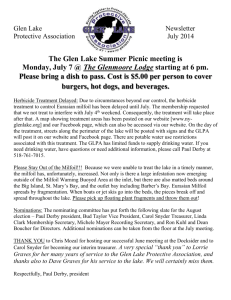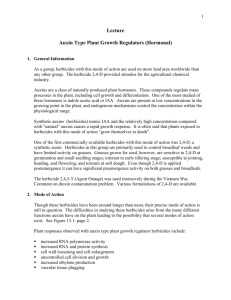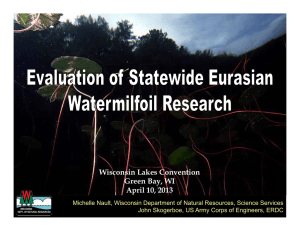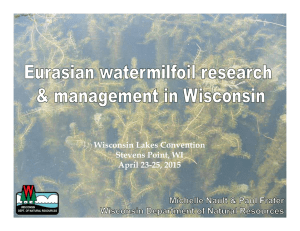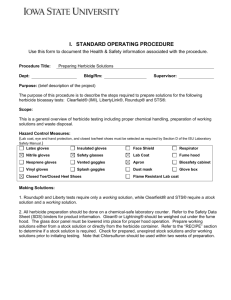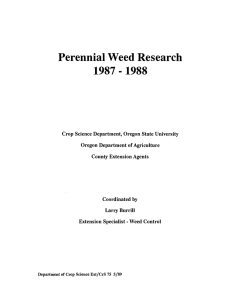Aquatic Herbicides and Invasive Plant Control in Midwestern Lakes Gainesville, FL
advertisement
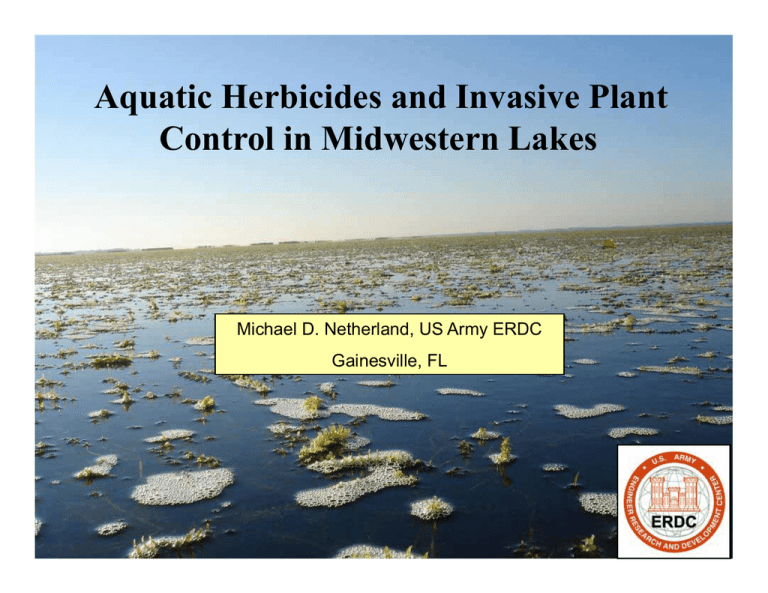
Aquatic Herbicides and Invasive Plant Control in Midwestern Lakes Michael D. Netherland, US Army ERDC Gainesville, FL Summary of Talk • Common herbicides in the upper Midwest – Rates, selectivity • Discussion of Concentration and Exposure Time (CET) Principles • Herbicide Residue Sampling – Linking residues to CET • Odds and Ends – New herbicides, New invasives, Hybrids, Eurasian watermilfoilDicotyledon Curlyleaf pondweedMonocotyledon Systemic Herbicides that Target Milfoil Product 2,4-D Control (1950, 76) Triclopyr Use Rates (ppm) 0.5 to 4.0 Notes Selective Milfoil No impact on CLP 0.5 to 2.5 Selective Milfoil Control (2002) No impact on CLP -B oth products have much stronger activity on dicotyledons -Some monocots can be sensitive - rate and timing -Emergents: bulrush, waterlily, nuphar Quiz: What do we mean by the term selectivity ? A typical 1.5 ppm application of 2,4-D or Triclopyr will control : A. Eurasian milfoil B. Curlyleaf Pondweed D. Illinois Pondweed E. Vallisneria C. Hydrilla F. Coontail Contact Herbicides for CLP & EWM Product Diquat Use Rates (ppm) 0.15 to 0.37 (1958) Notes Short exposure requirement Turbidity impacts efficacy Generally non-selective (placement) Endothall (1960) 1.0 to 3.0 Controls both EWM and CLP No Translocation (root crown ?) Fluridone (1986) - Will discuss in more detail What Do we Mean by ppm ? - 1 ppm Aquathol in 10 acres with 6 foot avg. depth Applied using GPS and calibrated pumps 38 gallons Aquathol into 19.6 million gallons of water 3.8 gallons per acre GPS tracks – can insure even application Environmental Fate Photolysis – fluridone (10- 45 d), triclopyr (2-7 d) - timing, water depth Microbial – 2,4-D (4-10 d), endothall (2-7 d) - large variations in half-lives (timing, water body) Deactivation – diquat (minutes to days) – negatively charged particles (sediments) in water column - Low Turbidity (NTU < 2) = high level of activity Herbicide Concentration >90% Control More than 1 way to kill the target plant Poor Control Exposure Time Herbicide CET Testing (Vicksburg MS, Gainesville, FL) Growth and Herbicide Testing (LAERF – Lewisville, TX) Why Monitor Residues ? • Herbicide Residue Monitoring - Perceived as a Regulatory Necessity (NPDES Permits ?) – Required for Product Registration – Monitoring focused on relief from water use restrictions – Limited field efforts to link efficacy/selectivity to residue • COST! COST! COST! • Development of ELISA (immunoassay) = cost-effective ability to monitor – Fluridone, triclopyr, 2,4-D, endothall, penoxsulam Background • SePRO Corp. developed an ELISA for fluridone • Fluridone = low use rates and long-lived product – Whole-lake applications = significant investment – Concerns regarding non-target selectivity – Testing was made commercially available • Monitoring emphasized efficacy & selectivity regulators insured of application rates – Used since the early 1990’s Houghton Lake 2002 Sonar A.S. Treatment Map 6 Boats 138 transects 100-m spacing 500 miles (800 km) Goal: 1 Day Is Fluridone the Only Compound Amenable to Operational Sampling ? Yes – Fluridone is unique as an aquatic herbicide - whole-lake treatments - need for bump applications - strict ppb requirement No – Sampling can provide valuable information - Determine residue behavior following application - Environmental factors that influence degradation - Comparison of application techniques or strategies The Scale or Timing of Treatment can Dictate Operational Sampling 280 ac. ~ 2700 ac. Dec 2008 Treatments 1500 ac Endothall Residue in Non-treated Sites Extended residuals explained widespread target plant control Residues can help to explain poor treatment results Early-season large-scale treatments in Lake Minnetonka Endothall 1 ppm + triclopyr 0.25 ppm – April 13, 08 Carman Bay 95 acres 48% of littoral Phelps Bay 150 acres 55% of littoral Gray’s Bay 160 acres 91% of Bay Endothall Target rate = 1000 pppb EWM symptoms Rapid recovery Rapid EWM recovery Early EWM control Late recovery Residues & Unexpected Results • Lake Tomahawk, WI Approx 150 acres Treated at 0.5 ppm 2,4-D Sampled through summer Residues phytoxic to EWM remained 2+ months post-treatment - Impacts to Native plants ? - Why was 2,4-D degradation so slow in this system ? - predicting microbial activity ? - Rates could have been reduced by 75% What Else is Going on in Aquatic Research – Northern perspective ? New Products Registered Carfentrazone (05) – contact herbicide Penoxsulam (07) – ALS inhibitor Imazamox (08) – ALS inhibitor - New products slow to Midwest 4 EUP compoundsFlumioxazin, bispyribac, quinclorac, topramazone, Hybrid or Spicatum ? Hybrid is difficult to distinguish from EWM – Morphology, growth 7 Decades of Milfoil Management – Is Hybridity a New Phenomenon or Just a Newly Discovered Phenomenon ? Hybrid documented in WA, ID, MN, WI, MI, VT widespread geographic distribution = distinct populations April 26, 2008 Harvest – Competition between genotypes 8 Months After Planting Each genotype = Collected from 2 different sites Hybrid Vigor ? Acquisition of a Parental Trait Turion Formation by Hybrid Milfoil: Significance to Management ? Hybrid Northern Cabomba – a worldwide invasive coming on strong Response of 3 phenotypes to Carfentrazone Variable Milfoil (VM) – When a good native goes bad -Easy to Distinguish Phenotypes -NH and GA are distinct strains of VM (genetic testing – Thum, and Moody) -NH strain was most aggressive in culture conditions (FL) ME Hybrid NH GA NH GA Response of Vallisneria Phenotypes to Management ? ACKNOWLEDGEMENTS • US Army ERDC – Aquatic Plant Control Research Program • FL FWC, MN DNR, NH DES, Univ. of FL • UPI, SePRO
